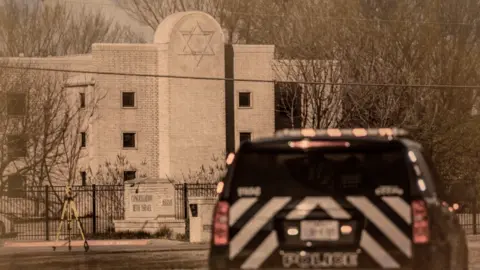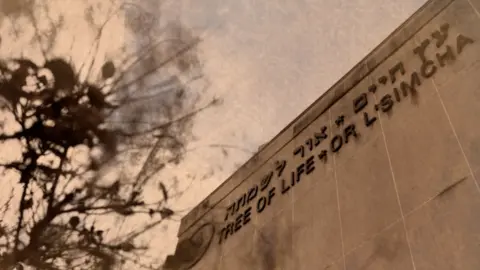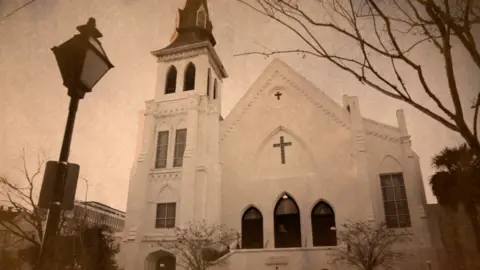Texas synagogue: How synagogues stay safe - and still welcoming
 Getty Images/BBC
Getty Images/BBC
A security crisis at the Congregation Beth Israel synagogue near Dallas, Texas ended with worshippers managing to escape and hostage taker Malik Faisal Akram shot dead by the FBI. But the stand-off has houses of faith asking: must they choose between sanctuary and safety?
The daylong siege ended with a sprint. After nearly 11 hours captive in his own synagogue, Beth Israel Rabbi Charlie Cytron-Walker threw a chair at the armed assailant and ran from the building with the two other hostages.
Outside, about 200 local, state and federal law enforcement officers had congregated, preparing to stage a rescue. But inside, the hostages had quietly been forming their own plans, while shifting furtively toward an exit.
"We escaped," Jeffrey Cohen, one of the hostages, wrote on Facebook after the incident. "We weren't released or freed."
Rabbi Cytron-Walker and Mr Cohen credited the escape to survival courses taken with their congregation. In recent years, a new security standard has been ushered in at Jewish American institutions - in large part a response to the devastating 2018 massacre at Pittsburgh's Tree of Life Synagogue, as well to a broader rise of anti-Semitic attacks in the US.
Active shooter drills, hostage training and bomb threat protocols have become routine. But what is lost when a place of worship is secured from the outside world? Can it remain a sanctuary?

The enhanced security traces a disturbing uptick in anti-Semitism in the US, according to the Anti-Defamation League (ADL), which tracks incidents of anti-Jewish bias and violence. In 2020, it recorded more than 2,000 anti-Semitic events, a 10% increase from the year before and the third-highest year on record since the ADL began recording in 1979.
The attack on the Tree of Life synagogue, in which 11 people were killed, remains the deadliest attack on Jewish Americans in US history.
Jewish American leaders often point to this assault as a turning point for security standards at synagogues. There was a before Tree of Life and an after, said Rabbi Hyim Shafner, who leads the Kesher Israel synagogue in Washington, DC.
"That was so surprising and so violent, I think every synagogue said to themselves: we need to beef things up," he said.

 Getty Images/BBC
Getty Images/BBC
Many synagogues already had a basic layer of protection, like video surveillance and locked doors. But after the Tree of Life shooting, rabbis and congregants enrolled in security courses offered by the FBI, the ADL, and other NGOs dedicated to securing Jewish institutions.
The Tree of Life attack was "a wake-up call," said Jonathan Greenblatt, head of the ADL. Mr Greenblatt estimated that tens of thousands of synagogues have sought out safety training in recent years.
"When I was a kid growing up in the 1970s I don't know that I could have imagined we would have armed guards in front of the synagogue," he said. "I think my children today cannot imagine a synagogue without armed guards."
Some have contracted groups like California-based Magen Am, which train congregation members to guard their own synagogues. The courses include firearm safety and hand-to-hand combat instruction.
"Anti-Semitism is a constant and security is a constant need, we need constant vigilance," said Rabbi Eilfort.
Some congregations have moved to fortify synagogues themselves, opting for exterior fencing and perimeter lighting.
But some in the Jewish community have raised concerns about how increased security measures affect places of worship - long considered sanctuaries both to believers and strangers.
Juliette Kayyem, a former assistant for homeland security under President Barack Obama, was asked by her husband's synagogue to advise on its new security committee formed in the wake of the Tree of Life attack.
Ms Kayyem, now the faculty chair of the homeland security programme at Harvard University, told the BBC she offered "cold calculations about risk and defence" typical of her industry. But some of her suggestions, namely entry-access security checks, went too far for the congregation.
"The challenge for synagogues and places of worship generally, is that there are some vulnerabilities that can't be mitigated without changing the identity of the institution," she said. "And that vulnerability is a desire to welcome the stranger."
Indeed, one of the more poignant elements of the attack on Beth Israel is that the attacker, British national Malik Faisal Akram, did not force his way in. Rabbi Cytron-Walker invited the 44-year-old inside.
"I said, 'Is this a night shelter?' and they let me in. And they gave me a cup of tea," Akram told negotiators during the standoff on Saturday. He was later killed by police.
The events recalled those at Mother Emanuel AME (African Methodist Episcopal) Church in Charleston in 2015, when self-described white supremacist Dylann Roof was welcomed inside by parishioners and invited to join an evening bible study, before he opened fire and killed nine black worshipers.

 Getty Images/BBC
Getty Images/BBC
"If a homeless person says 'I need a warm place', we should be doing that. Kindness is so built into Judaism, and all of our faiths," said Rabbi Shafner, from Kesher Israel in Washington, DC. "To be at a time in history when we can't do that because we're too worried - that is tragic."
Jewish leaders like Rabbi Shafner face a tug-of-war between sanctuary and security - between wanting their synagogues to remain open and the reality that Jewish Americans are, according to the FBI, consistently the most targeted religious community in the US.
Asked if there was a red line for security - a level that would compromise the essence of a synagogue - the ADL's Mr Greenblatt said he didn't know.
"We have to constantly evolve and adapt to circumstances," he said.
Ms Kayyem was more blunt.
"People like me look at the alternative to these defences," Ms Kayyem said. "And the alternative is a world that doesn't exist."

Graphics by Angélica Casas